外文翻译--旅游目的地品牌标识以斯洛文尼亚为例
公共场所双语标识英文译法-景区景点
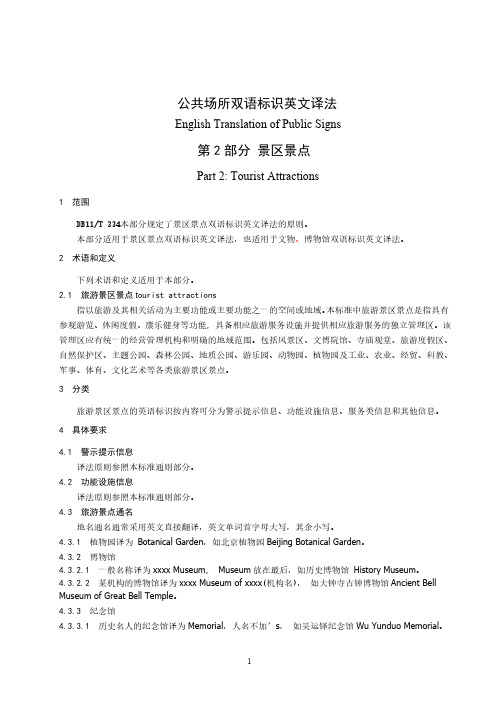
公共场所双语标识英文译法English Translation of Public Signs第2部分景区景点Part 2: Tourist Attractions1 范围DB11/T 334本部分规定了景区景点双语标识英文译法的原则。
本部分适用于景区景点双语标识英文译法,也适用于文物、博物馆双语标识英文译法。
2 术语和定义下列术语和定义适用于本部分。
2.1 旅游景区景点t ourist attractions指以旅游及其相关活动为主要功能或主要功能之一的空间或地域。
本标准中旅游景区景点是指具有参观游览、休闲度假、康乐健身等功能, 具备相应旅游服务设施并提供相应旅游服务的独立管理区。
该管理区应有统一的经营管理机构和明确的地域范围。
包括风景区、文博院馆、寺庙观堂、旅游度假区、自然保护区、主题公园、森林公园、地质公园、游乐园、动物园、植物园及工业、农业、经贸、科教、军事、体育、文化艺术等各类旅游景区景点。
3 分类旅游景区景点的英语标识按内容可分为警示提示信息、功能设施信息、服务类信息和其他信息。
4 具体要求4.1 警示提示信息译法原则参照本标准通则部分。
4.2 功能设施信息译法原则参照本标准通则部分。
4.3 旅游景点通名地名通名通常采用英文直接翻译,英文单词首字母大写,其余小写。
4.3.1 植物园译为Botanical Garden,如北京植物园Beijing Botanical Garden。
4.3.2 博物馆4.3.2.1 一般名称译为xxxx Museum, Museum放在最后,如历史博物馆History Museum。
4.3.2.2 某机构的博物馆译为xxxx Museum of xxxx(机构名),如大钟寺古钟博物馆Ancient Bell Museum of Great Bell Temple。
4.3.3 纪念馆4.3.3.1 历史名人的纪念馆译为Memorial,人名不加’s,如吴运铎纪念馆Wu Yunduo Memorial。
旅游品牌定位外文翻译文献

旅游品牌定位外文翻译文献(文档含英文原文和中文翻译)原文:Destination brand positions of a competitive set of near-home destinationsAbstract: Although the branding literature commenced during the 1940s, the first publications related to destination branding did not emerge until half a century later. A review of 74 destination branding publications by 102 authors from the first 10 years of destination branding literature (1998–2007) found at least nine potential research gaps warranting attention by researchers. In particular, there has been a lack of research examining the extent to which brand positioning campaigns have been successful in enhancing brand equity in the manner intended in the brand identity. The purpose of this paper is to report the results of an investigation of brand equity tracking for a competitive set of destinations in Queensland, Australia between 2003 and 2007.A hierarchy of consumer-based brand equity (CBBE) provided an effective means to monitor destination brand positions over time.A key implication of the results was the finding that there was no change in brand positions for any of the five destinations over the four year period. This leads to the proposition that destination position change within a competitive set will onlyoccur slowly over a long period of time. The tabulation of 74 destination branding case studies, research papers, conceptual papers and web content analyses provides students and researchers with a useful resource on the current state of the field.Keywords: Destination branding; Consumer-based brand equity; Short breaks; Destination image; Destination positioning IntroductionA brand is a distinguishing name and/or symbol (such as a logo, trademark, or package design) intended to identify the goods or services of either one seller or a group of sellers, and to differentiate those goods from those of competitors.Destination branding is the set of marketing activities that (1) support the creation of a name, symbol, logo, word mark or other graphic that readily identifies and differentiates a destination; that (2) consistently convey the expectation of a memorable travel experience that is uniquely associated with the destination; that (3) serve to consolidate and reinforce the emotional connection between the visitor and the destination; and that (4) reduce consumer search costs and perceived risk. Collectively, these activities serve to create a destination image that positively influences consumer destination choice.Branding is therefore considered mutually beneficial from boththe supply and demand perspectives. Enhancing the ability of the brand to differentiate effectively can generate advantages for products and services, such as increased purchase intent, lower costs, increased sales, price premiums, and customer loyalty. Advantages for destination marketing organisations (DMO) include increased potential to differentiate against places offering similar benefits, increased destination loyalty and increased yield for stakeholders such as local tourism businesses and travel intermediaries. Benefits for the traveller include ease of decision making through reduced search costs, reduced risk, and possibly enhanced brag value.The focus of most research reported to date has been concerned with the development of destination brand identities and the implementation of campaigns One area requiring increased attention is that of tracking the performance of destination brand positions over time. That is, the extent to which destination brands' positioning and repositioning campaigns have been effective in enhancing brand equity consistent with that intended in the brand identity. This is an important gap in the tourism literature, given: i) increasing competition ; ii) the increasing level of investment by destination marketing organisations (DMO); iii) the complex political nature of DMO brand decision making andincreasing accountability to stakeholders;iv) the long-term nature of repositioning a destination's image in the marketplace. In terms of metrics for DMOs in general, a number of researchers in various parts of the world have pointed to a lack of market research monitoring effectiveness of destination marketing objectives, such as in Australia, North America, and Europe.The aim of this study was to track the brand positions held by a competitive set of near-home destinations between 2003 and 2007. For this purpose the efficacy of a hierarchy of consumer-based brand equity (CBBE) was trialled. CBBE was first promoted by Aaker and Aaker and more recently by and to supplement traditional balance sheet brand equity measures. The rationale underpinning CBBE as a brand performance metric is that consumer perceptions of the brand underpin any financial estimate of future earnings estimated in the financial measure of brand equity. Since a financial balance sheet brand equity measure will be of little practical value to destination marketers, the concept of CBBE is worthy of consideration by DMOs. However, the potential of CBBE for destinations has only recently attracted the attention of academic researchers.Author:Steven PikeNationality:AustraliaSource:Tourism Management, In Press, Corrected Proof, Available online 24 January 2009译文:就近目的地竞争组的旅游目的地品牌定位摘要:尽管品牌学兴起于20世纪40年代,第一个与目的地品牌相关的出版物却直到半个世纪后才出现。
景区标识语英文翻译失误 How to improve student’s communicative skills when traveling
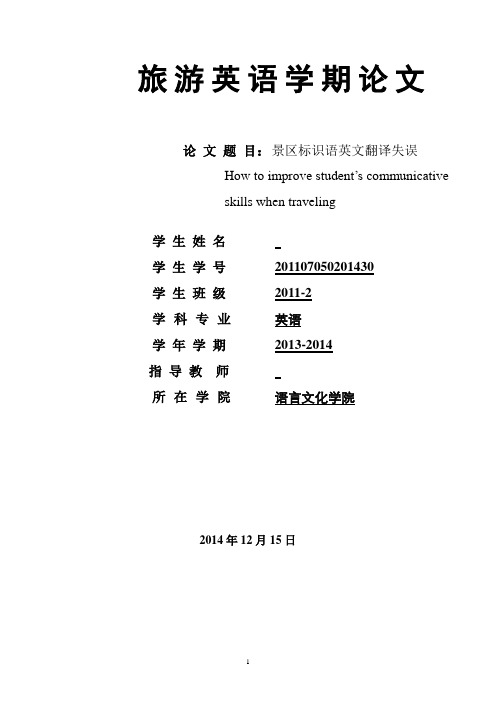
旅游英语学期论文论文题目:景区标识语英文翻译失误How to improve student’s communicativeskills when traveling学生姓名学生学号201107050201430学生班级2011-2学科专业英语学年学期2013-2014指导教师所在学院语言文化学院2014年12月15日摘要随着对外开放的不断发展,中英双语标识语越来越广泛地显现在城市的各个角落,在中外交流中发挥着极其重要的作用。
目前,景区标识语英文翻译的不规范、不准确极大地影响着石河子市对外交流的形象。
本研究尝试通过实例剖析石河子市各个景区标识语英文翻译的问题,并有针对性地提出一些规范化建议。
关键词:景区,标识语,中英翻译,分析,石河子市AbstractThe world is moving forward in an inconceivable speed, and with the development of tourist industry, Chinese-English signs are widely used in every corner of all cities, and play an significant role in communications between Chinese and foreign visitors. And at present, there are still a lot of mistakes and shortcomings among some scenic areas which can dwindle the good impressions in the mind of the foreign visitors. And this paper focus on the translation mistakes of the bilingual scenic signs through the analyses of the scenic areas in Shi Hezi city and gives some suggestions.Key words: scenic areas; signs; bilingual translation; Shihezi1.IntroductionAs the vehicle of communication, public signs do matter a lot, and the translation of pubic signs can not only effect every aspect among foreign visitors, but also can stand for the figure of a city. For this reason, the veracity of the bilingual public signs play a big role in city modeling, environmental construction and economic development. And in this paper, I will analyse the mistakes of the scenic signs which I found in Shihezi city, and give a reference for standardizing the translation of scenic signs.2. The major mistakes of the bilingual scenic signsThis year, I visit the major scenic areas in Shihezi city and collected a lot of bilingual scenic signs and found out many problems in the translation of scenic signs.2.1 Clerical errorsWhen analyse the bilingual pubic signs, I found some clerical errors.2.1.1 Wrong capital and small letterSuch as: NO Smoking And Firing In The Tourism AreaRengong lake2.1.2 Wrong lexical collocationThere are three versions of NON-RECYCLABLE:NON-RECYCLABLE, NO-RECYCLABLE, NOT-RECYCLABLE.And obviously, the first one is right.2.2 The default of the English translationIn some scenic areas, there is not any English translation among the public signs, and some only use pinyin instead of English, which can not deliver the correct connotation to the foreign visitors.Take “West Park” as an example. I can only see Chinese and pinyin on public signs, such as,西公园:XI GONG YUAN; 动物园:DONG WU YUAN; 静心亭:JIN XIN TING; 鱼米之乡风情园:YU MI ZHI XIANG FENG QING YUAN.Some places even leave out the pinyin. And these kinds of signs can not make foreign visitors understood.2.3 Choose inappropriate words and neglect the cultural connotationThere are many differences between Chinese and English such as the associative meaning, The established conventions, the shade of meaning and semantics range. So the translator willmake some ridiculous mistakes if he only choose the word according to literal meaning. For instance, 出口:Export.And cultural factors can not be bypassed when translate the public signs or mistakes will made. And we can see different versions of “toilet” signs in Century Park. Such as Toilet, WC, Washing Room. Although these three words deliver the same meaning, in western country, they are different. WC is old and scruffy, washing room often set in the building, and in scenic areas, toilet is the best choice.2.4 Use ChinglishTranslation is a skill, an art and a creation, the translators need to be equipped with well language skills and translation skills, not only to pile the words up. However, I found a lot of mistakes in grammar and structure, and most of them are not English at all. Such as:请勿下水,注意安全。
外宣翻译原则下旅游景区标识语翻译错例解析
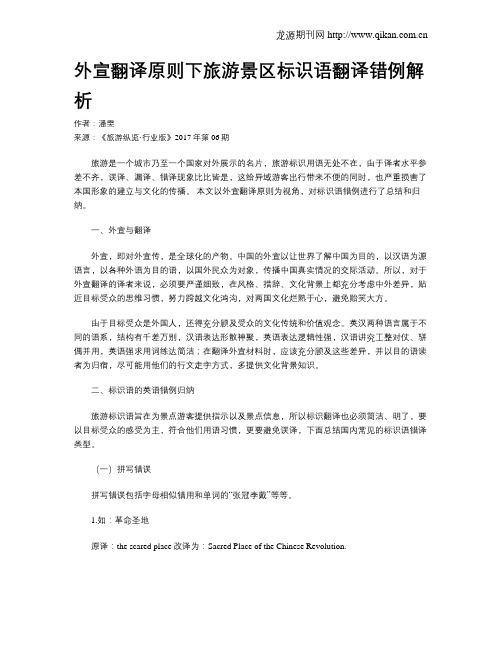
外宣翻译原则下旅游景区标识语翻译错例解析作者:潘雯来源:《旅游纵览·行业版》2017年第06期旅游是一个城市乃至一个国家对外展示的名片,旅游标识用语无处不在,由于译者水平参差不齐,误译、漏译、错译现象比比皆是,这给异域游客出行带来不便的同时,也严重损害了本国形象的建立与文化的传播。
本文以外宣翻译原则为视角,对标识语错例进行了总结和归纳。
一、外宣与翻译外宣,即对外宣传,是全球化的产物。
中国的外宣以让世界了解中国为目的,以汉语为源语言,以各种外语为目的语,以国外民众为对象,传播中国真实情况的交际活动。
所以,对于外宣翻译的译者来说,必须要严谨细致,在风格、措辞、文化背景上都充分考虑中外差异,贴近目标受众的思维习惯,努力跨越文化鸿沟,对两国文化烂熟于心,避免贻笑大方。
由于目标受众是外国人,还得充分顾及受众的文化传统和价值观念。
英汉两种语言属于不同的语系,结构有千差万别,汉语表达形散神聚,英语表达逻辑性强,汉语讲究工整对仗、骈偶并用,英语强求用词练达简洁;在翻译外宣材料时,应该充分顾及这些差异,并以目的语读者为归宿,尽可能用他们的行文走字方式,多提供文化背景知识。
二、标识语的英语错例归纳旅游标识语旨在为景点游客提供指示以及景点信息,所以标识翻译也必须简洁、明了,要以目标受众的感受为主,符合他们用语习惯,更要避免误译,下面总结国内常见的标识语错译类型。
(一)拼写错误拼写错误包括字母相似错用和单词的“张冠李戴”等等。
1.如:革命圣地原译:the scared place改译为:Sacred Place of the Chinese Revolution.“scared”与“sacred”两个单词拼写较为相似,但是意思却有天壤之别,“scared”是“可怕的”,细微的差异会造成极其恶劣的政治影响。
濒危物种2.原译:Dangerous Species改译为:Endangered Species.“dangerous”是“危险的”意思,“濒危”是自身处于危险之地。
旅游目的地品牌识别——斯洛文尼亚案例【外文翻译】
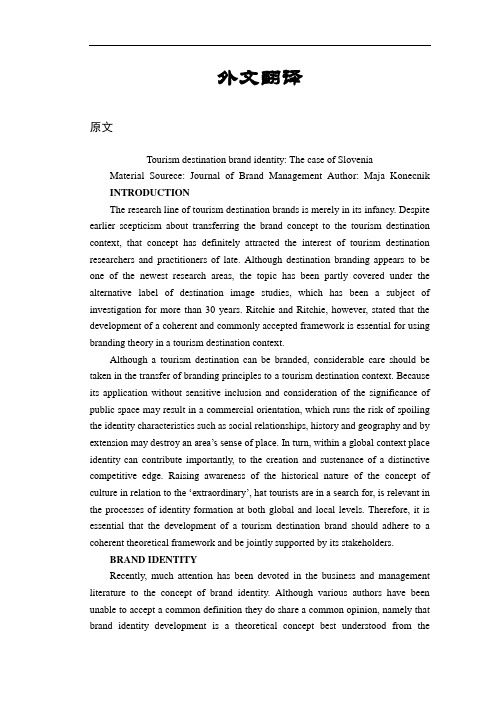
外文翻译原文Tourism destination brand identity: The case of Slovenia Material Sourece:Journal of Brand Management Author:Maja Konecnik INTRODUCTIONThe research line of tourism destination brands is merely in its infancy. Despite earlier scepticism about transferring the brand concept to the tourism destination context, that concept has definitely attracted the interest of tourism destination researchers and practitioners of late. Although destination branding appears to be one of the newest research areas, the topic has been partly covered under the alternative label of destination image studies, which has been a subject of investigation for more than 30 years. Ritchie and Ritchie, however, stated that the development of a coherent and commonly accepted framework is essential for using branding theory in a tourism destination context.Although a tourism destination can be branded, considerable care should be taken in the transfer of branding principles to a tourism destination context. Because its application without sensitive inclusion and consideration of the significance of public space may result in a commercial orientation, which runs the risk of spoiling the identity characteristics such as social relationships, history and geography and by extension may destroy an area’s sense of place. In turn, within a global context place identity can contribute importantly, to the creation and sustenance of a distinctive competitive edge. Raising awareness of the historical nature of the concept of culture in relation to the ‘extraordinary’, hat tourists are in a search for, is relevant in the processes of identity formation at both global and local levels. Therefore, it is essential that the development of a tourism destination brand should adhere to a coherent theoretical framework and be jointly supported by its stakeholders.BRAND IDENTITYRecently, much attention has been devoted in the business and management literature to the concept of brand identity. Although various authors have been unable to accept a common definition they do share a common opinion, namely that brand identity development is a theoretical concept best understood from thesupply-side perspective. Kapferer (p.71) provides a very simple and clear explanation to gain an understanding of brand identity that underscores the significance of the supply-side perspective on the brand concept: ‘before knowing how we are perceived, we must know who we are’. According to his explanation, the tourist destination, rather than the consumer, should define both its brand and content. A tourist destination is a complex concept, which is based on a myriad of different products, services and experiences; managed by different stake-holders (tourism industry sector, public sector, government, destination management organisation, locals) with a variety of ownership forms and often without an appropriate hierarchy with a set of rules for stakeholders to adhere to. Within such context, a brand identity can serve as a network picture, which draws, in turn on historical, national and cultural relation-ships to develop a common view, which becomes the basis for joint action for/or against change. In that sense, the supply-centric perspective of brand identity is significant and, among others, recognized by the International Corporate Identity Group, within the meaning of corporate identity proposed by Ind.The multiple roles of the brand identity concept are reflected in investigations. For example, Kapferer50 introduced a hexagonal model called the brand identity prism. It is based on six central components: physique, personality, culture, relationship, reflection or image and self-image. Later, de Chernatony’s model adapted Kapferer’s brand identity prism. In our opinion, Aaker and Joachimsthaler’s brand leadership model is so far the most salient one in the literature for three reasons. First, the model is systematic. Branding can easily become overwhelming in the multitude of components and theories that play a role in brand identity development. Therefore, there is a need to provide guidelines enabling decision makers to examine issues utilizing a three-phased structure: a pre-analysis of strategic processes; a tourism destination brand identity system analysis and a post-brand implementation process. Secondly, the model is comprehensive, that is, its brand leadership model underscores the subject in its breadth. The model covers both the strategic and visionary roles of managers rather than limiting the discussion to their tactical and reactive roles. It focuses on the issue of strategic brand control, that is, setting out what a brand should stand for from the perspective of relevant stakeholders, including customers and subsequently, communicating the desired corporate identity consistently, efficiently and effectively. Thirdly, the model is pragmatic because it recognizes that decision makers should be involved in bothformulating and implementing the business strategy. Both the strategic vision of the decision makers and their corporate culture should have a significant influence on the destination’s brand strategy. In practical terms, it implies that a destination brand identity strategy should not promise what a destination cannot or will not deliver.TOURISM DESTINATION BRAND IDENTITY FRAMEWORKThis implies that the research that combines the marketing literature (focusing mostly on the brand concept) with the tourism literature (focusing primarily on a destination’s image) is still in its infancy. The most comprehensive and recent work to date in the literature that clearly high-lights the difference between the image-formation process and branding was published by Cai. This observation is significant because image formation is not synonymous with branding, albeit that the former constitutes the core of the latter. Image building comes one step closer but it lacks a critical link, namely, with brand identity. By underscoring the significance of the brand identity concept at the destination level, Cai’s work identified the main theoretical weaknesses of destination brand studies driven by a customer-centric perspective. Also, Cai proposed a conceptual model of destination branding that centres on building a destination identity through spreading activation theory. The latter results from a logic of dynamic link-ages that results from the activation of the brand element mix, subsequent image building, brand associations and marketing activities. Another advantage of the model is that it recognises that image, ‘as projected by the destination management organization’. According ly, it should be possible to assess the gap between the perceived and the projected image. The assessment provides an appropriate input for building the desired image that is consistent with the brand identity and ‘organizes social, historical, cultural an d natural elements into a stream of impressions’. Within Cai’s model of destination branding the marketing function’s role is emphasised, while the model does not go into detail on how to build and develop a brand identity for a specific destination.The tourism destination brand identity system represents the process of developing a destination brand identity, which incorporates relevant local cultural characteristics. As Aaker and Joachimsthaler suggested, a destination brand identity should include 6–12 such dimensions in order to adequately describe the aspirations of a particular brand. At least one of these dimensions must differentiate the tourism destination from competing destinations. Although these dimensions can vary from one destination to another, they can be summarised by four brand characteristics to persuade tourists to visit Slovenia instead of other destinations. These are the brandas a product, the brand as a symbol, the brand as an organization and the brand as a personality. Modern t ourists want to experience ‘a sense of place’ when visiting a destination. Therefore, experiential and symbolic benefits play as important role as functional benefits in a destination brand’s identity.CONCLUSIONSIn the literature, the importance of the brand identity concept seems to be commonly accepted as an important perspective on brand investigation. In contrast, the tourism research publications have paid little attention to this topic. This observation presented a motive for the present paper, which provides theoretical underpinning for the tourism destination brand concept from the owner’s perspective. One justification for the paper is that it complements previous investigations that approached tourism destination branding from a perceived image perspective. We underscore in our paper, the potential danger of prescriptions, which result from a single-minded tourist-centric perspective. The identity-based approach offers a counter perspective to tourist- driven marketing, n that it affords ‘insiders’ the opportunity to project their image of Slovenia’s essence and within such context experience identity, that is, to connect in one way or another with the emotional feelings of the host.译文旅游目的地品牌识别——斯洛文尼亚案例资料来源:品牌管理的杂志作者:玛雅简介与许多以产品品牌为主题的科学贡献不同的是(很少的服务和企业品牌),旅游目的地品牌研究路线,只是处于起步阶段。
Slovenia斯洛文尼亚 名字里都写着LOVE
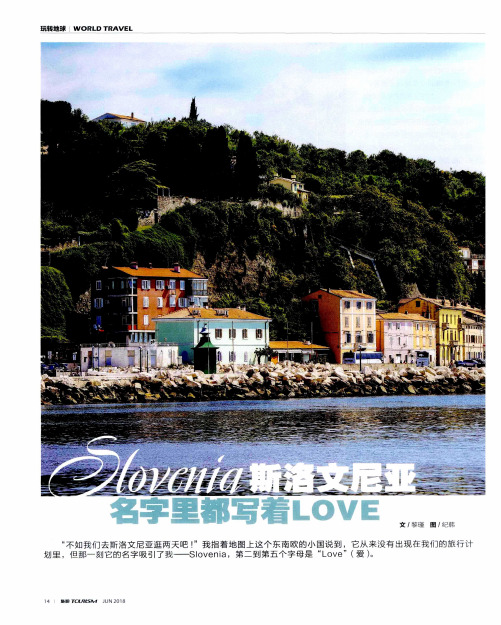
人沿 着地 下 河进 入 洞穴 ,气 温 骤 降 ,四周 只 剩下 潮湿 与黑 暗 ,越 是 向下越 是 阴
ห้องสมุดไป่ตู้
令,只有水 流 奔腾 的声 音 。
河 水湍 急 ,雷 卡河 (Reka River)的地 下峡 谷是 迄 今为 止世 界上 已知 规模
最 大 的地 下 峡谷 。我们 摸黑 走 过河 上摇 摇 晃晃 的 铁桥 ,又 摸 索着 铁链 贴着 山 腹
言 ,在 这 片地 rXt ?0,短 暂 旅程 是 那个 波 折不 断 的初 夏 最浪 漫 暗之 吻 ,既惊 险刺 激 ,又 足够私 密 。
的惊 喜 。
1小 镇 皮 兰 。 2奔 腾 的河 水 。 3树 林 里 的昆 虫 。 4挂 着 石 笋的 溶 洞大 厅
JUN 2018 碡 蝣 n 片
我们 沿 着木 栈 道从 巨 大的 盐 田 中穿过 ,四 周都 是 平坦 的浅 蓝 色水 面 ,几 只 洁 白的 海鸟 在 水 中嬉 戏 。这 里 已经十 分 靠 近海 岸 ,自1 4世 纪起 ,斯 洛 文 尼亚 人 就开 始把 海 水 引 入 蒸 发 池 ,进行 蒸 发 、结 晶 ,并 利 用 海藻 、石 膏 、碳 酸盐 等 天然 材料 分开 海泥 与 海盐 。
栈道 尽 头处 的 博物 馆 展示 了 中世 纪 传统 的 产盐 方 式 , 以及 传 统的 盐 工 住房 。700年 过 去 了 ,如 今 的人 们 依 然采 用 这种 传 统 方式 进行 生 产 。由此 得 到 的海 盐 富含 更 多矿 物 质 和微 量 元 素 ,口感与 工 业 加工 的 盐有 微 妙 的 区别 ,是非 常 受欢 迎的 旅行 纪念 品 。
得 超乎 想 象 ,宏 伟 的大 厅生 长着 巨型石 笋 ,当 穿越 一 系列 瀑布 和壮 丽 的钙化 池
公共场所双语标识英文译法景区景点
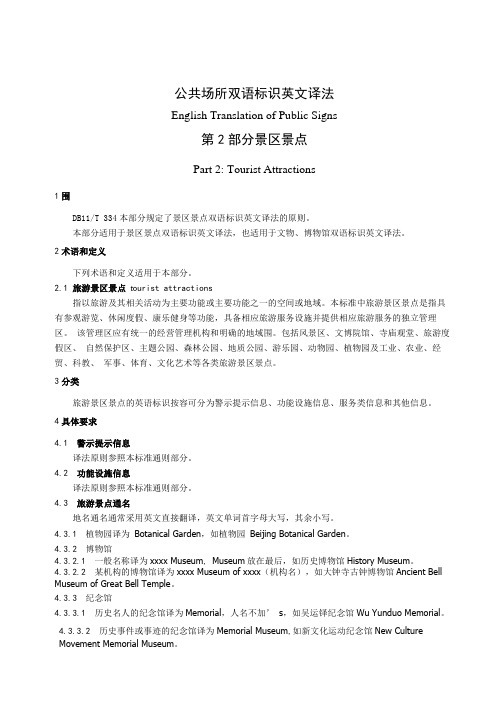
公共场所双语标识英文译法English Translation of Public Signs第2部分景区景点Part 2: Tourist Attractions1围DB11/T 334本部分规定了景区景点双语标识英文译法的原则。
本部分适用于景区景点双语标识英文译法,也适用于文物、博物馆双语标识英文译法。
2术语和定义下列术语和定义适用于本部分。
2.1 旅游景区景点t ourist attractions指以旅游及其相关活动为主要功能或主要功能之一的空间或地域。
本标准中旅游景区景点是指具有参观游览、休闲度假、康乐健身等功能,具备相应旅游服务设施并提供相应旅游服务的独立管理区。
该管理区应有统一的经营管理机构和明确的地域围。
包括风景区、文博院馆、寺庙观堂、旅游度假区、自然保护区、主题公园、森林公园、地质公园、游乐园、动物园、植物园及工业、农业、经贸、科教、军事、体育、文化艺术等各类旅游景区景点。
3分类旅游景区景点的英语标识按容可分为警示提示信息、功能设施信息、服务类信息和其他信息。
4具体要求4.1警示提示信息译法原则参照本标准通则部分。
4.2功能设施信息译法原则参照本标准通则部分。
4.3旅游景点通名地名通名通常采用英文直接翻译,英文单词首字母大写,其余小写。
4.3.1植物园译为Botanical Garden,如植物园Beijing Botanical Garden。
4.3.2博物馆4.3.2.1一般名称译为xxxx Museum, Museum放在最后,如历史博物馆History Museum。
4.3.2.2某机构的博物馆译为xxxx Museum of xxxx(机构名),如大钟寺古钟博物馆Ancient Bell Museum of Great Bell Temple。
4.3.3纪念馆4.3.3.1历史名人的纪念馆译为Memorial,人名不加’ s,如吴运铎纪念馆Wu Yunduo Memorial。
公共场所双语标识英文译法-景区景点2
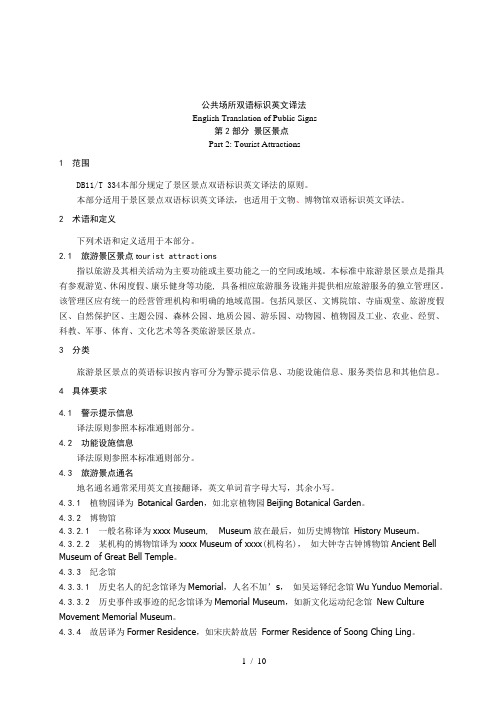
公共场所双语标识英文译法English Translation of Public Signs第2部分景区景点Part 2: Tourist Attractions1 范围DB11/T 334本部分规定了景区景点双语标识英文译法的原则。
本部分适用于景区景点双语标识英文译法,也适用于文物、博物馆双语标识英文译法。
2 术语和定义下列术语和定义适用于本部分。
2.1 旅游景区景点t ourist attractions指以旅游及其相关活动为主要功能或主要功能之一的空间或地域。
本标准中旅游景区景点是指具有参观游览、休闲度假、康乐健身等功能, 具备相应旅游服务设施并提供相应旅游服务的独立管理区。
该管理区应有统一的经营管理机构和明确的地域范围。
包括风景区、文博院馆、寺庙观堂、旅游度假区、自然保护区、主题公园、森林公园、地质公园、游乐园、动物园、植物园及工业、农业、经贸、科教、军事、体育、文化艺术等各类旅游景区景点。
3 分类旅游景区景点的英语标识按内容可分为警示提示信息、功能设施信息、服务类信息和其他信息。
4 具体要求4.1 警示提示信息译法原则参照本标准通则部分。
4.2 功能设施信息译法原则参照本标准通则部分。
4.3 旅游景点通名地名通名通常采用英文直接翻译,英文单词首字母大写,其余小写。
4.3.1 植物园译为Botanical Garden,如北京植物园Beijing Botanical Garden。
4.3.2 博物馆4.3.2.1 一般名称译为xxxx Museum, Museum放在最后,如历史博物馆History Museum。
4.3.2.2 某机构的博物馆译为xxxx Museum of xxxx(机构名),如大钟寺古钟博物馆Ancient Bell Museum of Great Bell Temple。
4.3.3 纪念馆4.3.3.1 历史名人的纪念馆译为Memorial,人名不加’s,如吴运铎纪念馆Wu Yunduo Memorial。
旅游翻译中的用词及翻译

LOGO
中:云南有26个少数民族,是中国少数民 族种类最多的省份。各民族的服饰、建筑、 风俗、歌舞、饮食等,形成了一幅美丽的 风情画卷。 英:Home to 26 ethnic groups—the largest number in China—Yunnan Province offers tourists a cultural feast of unique ethnic costumes, architectures, customs, cuisines, songs and dances.
LOGO
英:You’re not permitted to bring your own food to the park; you can only consume the fast food sold on the premises. 译:不允许自带食物进入公园 ,只能在里面的快餐店用餐。
LOGO
英文:Out of all of America’s symbols, none has proved more enduring or evocative than the Statue of Liberty. 译文1:在美国所有的标志中,没 有比“自由女神”更持久、更具感 召力的了。 译文2:在美国所有的标志当中, “自由女神”最为持久,也最具感 召力。
LOGO
英汉旅游文体特色
汉语语言表达常常人文色彩浓郁,物 我一体,具有一种超越现实、虚实不 定的朦胧、变形之美,一景一物,皆 有灵性,主观色彩浓厚 英语表达客观、简约,语言上追求一 种自然理性之美,行文用字最忌重复 堆砌;另一方面,十分讲究句式结构 的逻辑层次和有机组合,语法规则十 分严格,反映出英语表达逻辑严谨、 思想缜密的美学特点。
旅游景点公共标识语英译浅析
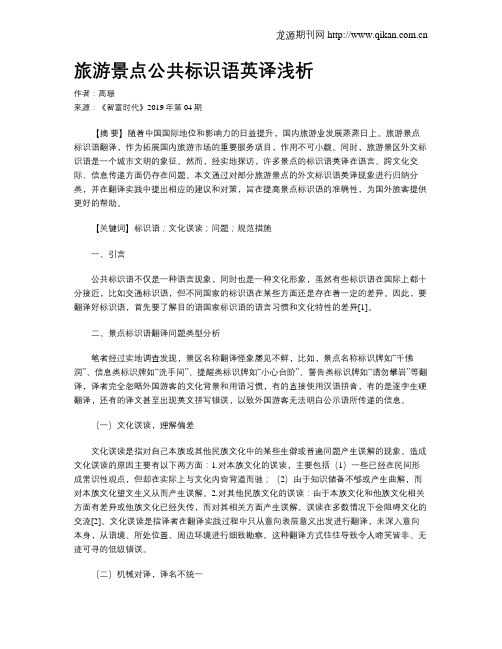
旅游景点公共标识语英译浅析作者:高珊来源:《智富时代》2019年第04期【摘要】随着中国国际地位和影响力的日益提升,国内旅游业发展蒸蒸日上。
旅游景点标识语翻译,作为拓展国内旅游市场的重要服务项目,作用不可小觑。
同时,旅游景区外文标识语是一个城市文明的象征。
然而,经实地探访,许多景点的标识语英译在语言、跨文化交际、信息传递方面仍存在问题。
本文通过对部分旅游景点的外文标识语英译现象进行归纳分类,并在翻译实践中提出相应的建议和对策,旨在提高景点标识语的准确性,为国外旅客提供更好的帮助。
【关键词】标识语;文化误读;问题;规范措施一、引言公共标识语不仅是一种语言现象,同时也是一种文化形象,虽然有些标识语在国际上都十分接近,比如交通标识语,但不同国家的标识语在某些方面还是存在着一定的差异。
因此,要翻译好标识语,首先要了解目的语国家标识语的语言习惯和文化特性的差异[1]。
二、景点标识语翻译问题类型分析笔者经过实地调查发现,景区名称翻译怪象屡见不鲜,比如,景点名称标识牌如“千佛洞”、信息类标识牌如“洗手间”、提醒类标识牌如“小心台阶”、警告类标识牌如“请勿攀岩”等翻译,译者完全忽略外国游客的文化背景和用语习惯,有的直接使用汉语拼音,有的是逐字生硬翻译,还有的译文甚至出现英文拼写错误,以致外国游客无法明白公示语所传递的信息。
(一)文化误读,理解偏差文化误读是指对自己本族或其他民族文化中的某些生僻或普遍问题产生误解的现象。
造成文化误读的原因主要有以下两方面:1.对本族文化的误读,主要包括(1)一些已经在民间形成常识性观点,但却在实际上与文化内容背道而驰;(2)由于知识储备不够或产生曲解,而对本族文化望文生义从而产生误解。
2.对其他民族文化的误读:由于本族文化和他族文化相关方面有差异或他族文化已经失传,而对其相关方面产生误解。
误读在多数情况下会阻碍文化的交流[2]。
文化误读是指译者在翻译实践过程中只从意向表层意义出发进行翻译,未深入意向本身,从语境、所处位置、周边环境进行细致勘察。
国家冷知识之斯洛文尼亚,31个你可能不知的有趣事实(二)
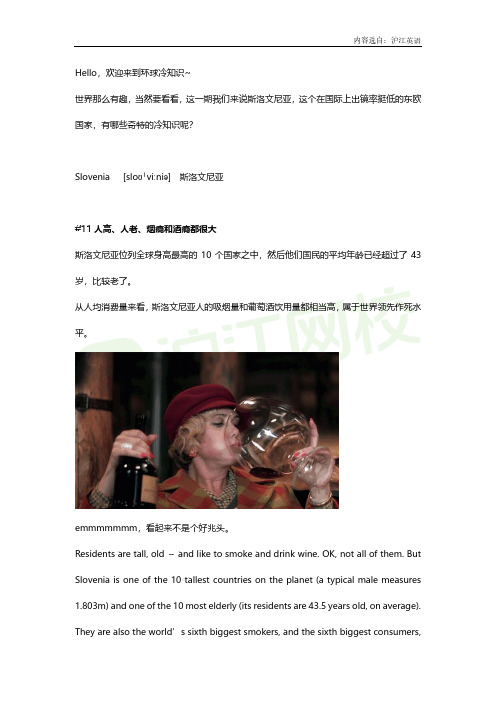
Hello,欢迎来到环球冷知识~世界那么有趣,当然要看看,这一期我们来说斯洛文尼亚,这个在国际上出镜率挺低的东欧国家,有哪些奇特的冷知识呢?Slovenia [sloʊˈviːniə] 斯洛文尼亚#11 人高、人老、烟瘾和酒瘾都很大斯洛文尼亚位列全球身高最高的10个国家之中,然后他们国民的平均年龄已经超过了43岁,比较老了。
从人均消费量来看,斯洛文尼亚人的吸烟量和葡萄酒饮用量都相当高,属于世界领先作死水平。
emmmmmmm,看起来不是个好兆头。
Residents are tall, old –and like to smoke and drink wine. OK, not all of them. But Slovenia is one of the 10 tallest countries on the planet (a typical male measures 1.803m) and one of the 10 most elderly (its residents are 43.5 years old, on average). They are also the world’s sixth biggest smokers, and the sixth biggest consumers,per capita, of wine.斯洛文尼亚的居民个子高且年龄偏大,他们喜欢抽烟、喝葡萄酒。
当然,并不是所有人都这样。
但斯洛文尼亚是全球居民身高最高的十个国家之一(一名普通男性的身高为1.803米),也是全球居民年龄最大的十个国家之一(其居民的平均年龄为43.5岁)。
在烟民人数上,该国在全球排名第六。
斯洛文尼亚也是人均第六大葡萄酒消费国。
#12 另一个旅游胜地:马里博尔如果要问斯洛文尼亚的哪些城市适合旅游,那除了首都卢布尔雅那,肯定就得说说马里博尔 Maribor图片来源:Nikola Jurisic/slovenia它是斯洛文尼亚的第二大城市,也是个游客爱去的城市,这里每个季节都有当季的特色活动,比如春天的狂欢节、冬天的滑雪大赛,还有美食节、歌剧之夜等等。
WALTEK------各国认证标志对照
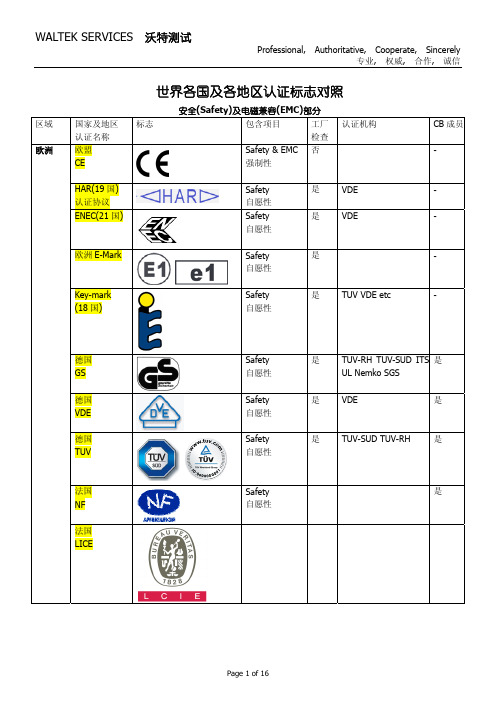
Safety & EMC
PCBC
是
自愿性
Safety & EMC
MEEI
是
自愿性
Safety & EMC
TSE
是
自愿性
Safety
是
UL
是
自愿性
Safety
是
ITS
是
自愿性
Safety
是
CSA
是
自愿性
Page 3 of 16
WALTEK SERVICES 沃特测试
美国 FCC
美国 FDA 美国 DOT
欧盟 Energy+
欧洲
德国 蓝天使 Blue Angel
瑞典 TCO 99
自愿
欧洲 欧盟与 13 个 法规要求:2003/66/EC 指令和
超过 国家协调机构 EN153 的测试程序
400 种
产品类别:电冰箱、冷冻机
设备
注册费用:免费
电气安全性:无;噪音辐射:无
能耗>>
在 1 年内整体能源消耗
Energy Saving Recommended Label
Safety & EMC 是
KTL,KETI
是
强制性
Safety
是
自愿性
EMC
是
强制性
Safety
否
PSB
是
强制性
TISI
是*
强制性
自愿性
Safety 强制性
是
BPS
越南 TCVN
中国台湾 BSMI
中国台湾 DGT
沙特 SASO 科威特 ICCP
Safety & EMC 强制性
斯洛文尼亚旅游景点

斯洛文尼亚旅游景点
以下是斯洛文尼亚一些著名的旅游景点:
1. 卢布尔雅那(Ljubljana)- 斯洛文尼亚的首都,有着历史悠久的城堡、美丽的特里佩尔桥和欧洲风格的建筑。
2. 布莱德湖(Lake Bled)- 斯洛文尼亚最受欢迎的旅游景点之一,湖中有一座浪漫的岛屿,景色宜人,周围有山峦环绕。
3. 女王洞(Postojna Cave)- 是斯洛文尼亚最大的洞穴系统之一,有着壮观的钟乳石和石笋。
4. 神庙山(Mount Triglav)- 斯洛文尼亚最高峰,位于尤利亚山脉中,是徒步爱好者的天堂。
5. 比斯特里察(Bled Castle)- 位于布莱德湖的岸边,是斯洛文尼亚最古老的城堡之一,可以俯瞰整个湖区的美景。
6. 普雷德约尔斯卡尼亚(Predjama Castle)- 是一座建在岩石洞穴里的城堡,有着悠久的历史和神秘的传说。
7. 斯科卡湖(Lake Bohinj)- 是斯洛文尼亚最大的湖泊,位于特里格拉夫国家公园内,被山脉和森林环绕。
8. 地球热点(Postojna)- 是一个地下地貌景观,有着壮观的地壳变动和地下河流。
9. 温泉城市罗加斯卡索卡(Rogaška Slatina)- 有着世界著名的温泉疗养中心和古老的建筑。
10. 莱什奇卡湖(Lake Cerknica)- 是一个独特的湖泊,根据季节不同,湖水的大小和形状会发生变化。
这些景点都有着独特的自然风光和悠久的历史,使斯洛文尼亚成为一个迷人的旅游目的地。
外文翻译--中国游客新的旅游目的-品牌
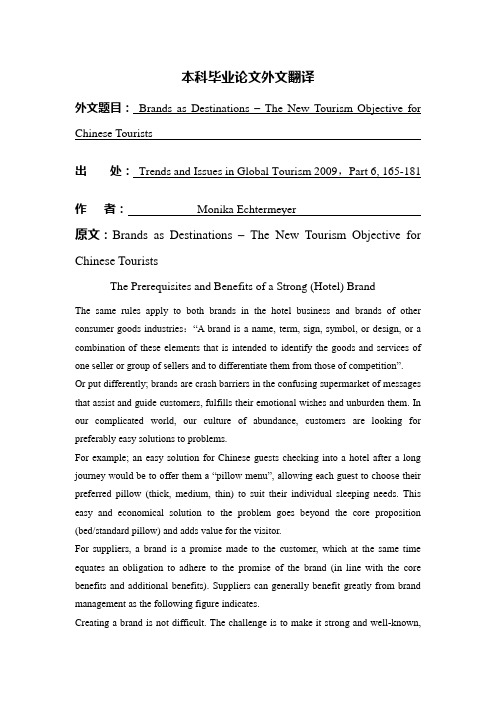
本科毕业论文外文翻译外文题目:Brands as Destinations –The New Tourism Objective for Chinese Tourists出处:Trends and Issues in Global Tourism 2009,Part 6, 165-181作者:Monika Echtermeyer原文:Brands as Destinations –The New Tourism Objective for Chinese TouristsThe Prerequisites and Benefits of a Strong (Hotel) BrandThe same rules apply to both brands in the hotel business and brands of other consumer goods industries:“A brand is a name, term, sign, symbol, or design, or a combination of these elements that is intended to identify the goods and services of one seller or group of sellers and to differentiate them from those of competition”.Or put differently; brands are crash barriers in the confusing supermarket of messages that assist and guide customers, fulfills their emotional wishes and unburden them. In our complicated world, our culture of abundance, customers are looking for preferably easy solutions to problems.For example; an easy solution for Chinese guests checking into a hotel after a long journey would be to offer them a “pillow menu”, allowing each guest to choose their preferred pillow (thick, medium, thin) to suit their individual sleeping needs. This easy and economical solution to the problem goes beyond the core proposition (bed/standard pillow) and adds value for the visitor.For suppliers, a brand is a promise made to the customer, which at the same time equates an obligation to adhere to the promise of the brand (in line with the core benefits and additional benefits). Suppliers can generally benefit greatly from brand management as the following figure indicates.Creating a brand is not difficult. The challenge is to make it strong and well-known,so that it works in practice and actually gets recognized. There are numerous brands in the hotel business,but only a few have managed to establish themselves worldwide.Prerequisites, Challenges and Benefits of a Strong Destination BrandThe same principles do not apply to brands of destinations as to those of the hotel industry or other consumer-goods industries. Ritchie and Crouch(2003)defined destination brands as follows: “A destination brand is a name, symbol, logo, work mark or other graphic that both identifies and differentiates the destination; furthermore it conveys the promise of a memorable travel experience that is uniquely associated with the destination; it also serves to consolidate and reinforce the recollection of pleasurable m emories of the destination experience”. Positioning tourist destinations in terms of emotional dimensions is better in the majority of cases than concentrating on the objective core benefits, as the ranges of products and services offered by different regions nowadays are often very similar. The specific emotional benefit must be expressed by its positioning, thereby differentiating a destination from its competition. Knowledge of the region’s core competences is thereby crucial, for example: The Austrian national tourist office, Österreich Werbung (ÖW), introduced a paradigm shift a few years ago and changed the product-orientated marketing strategy to one creating a sense of identity. ÖW was the first European NTO to promote values rather than themes. Austria positioned itself as the “world’s most charming holiday destination”. They implemented these values through “story telling,” using two “charming penguins” called Joe and Sally. However, using two penguins as mascots for Austria was not as successful as expected. Particularly since there is not a single wild penguin in Austria, and tourists certainly do not associate Austria with penguins.Once a supplier has established a brand and is better-known than its competitors, it is vital to maintain this advantage and expand on it. In this process, new products should not be developed from the company’s perspective but should rather be consumer-orientated, following the motto: “It is not the fisherman that should savorthe bait, but the fish”.Brands are most important in the extreme ends of the market; that is to say, in the low budget sector and in the luxury sector, although they have differing functions in each. In the low budget sector, a brand offers safety and the customer avoids any nasty surprises. Low budget brands are usually highly standardized. In the luxury sector, however, brands are seen as status symbols and therefore cannot be uniform. Although the brand guarantees certain basic standards, guests expect different hotels of a chain to be individually designed, and that a Ritz Carlton in Los Angeles looks different to a Ritz Carlton in Shanghai.:The brand name and the brand image should be unmistakable and suit the target group. The brand name and image in turn determine the product and the value of the brand.Cultural and Economic Reasons for Chinese Tourists’ Brand ConsumptionBrands are an area of conflict between globalised economic values and no globalised diverse cultural aspects. As a result, brand awareness has varying characteristics, dependent on culture.Experts talk about the existence of a clear East West divide : Eastern Europe has been affected by the extended absence of western branded goods. This is why well-established and distinguished (western) brands, which embody personal status, enjoy great significance. This also applies to hotel brands and will remain the case for some time.However, it is impossible to speak generally and sweepingly of ‘Chinese brand preferences’. China is a vast land with 1.3 billion people, who se local culture, industrial structure and consumer buying habits vary considerably from one province to the next. European tourism managers in marketing should therefore not speak about ‘Chinese tourists’ in general, but should develop an understanding of the varying interests and desires of tourists from the particular provinces. The source markets Beijing, Shanghai and Guangzhou are the three cities with the most accurate characteristics of the Chinese outbound market. More information on this can be found in a study by the World Tourism Organization 2003, titled ‘Marketing onChinese outbound tourism’.In conclusion, one could say that the development of a brand image is highly important in future competition, whether it be in the Chinese, Indian or Russian markets, or any other for that matter. It is of particular relevance for the first-time customers. Every country has particular products, symbols or characteristics that define the brand image of the country and as such act as export produce in the tourism industry. Successful tourism offers are always simple solutions in our society of abundance. They recognize the slightest conscious and unconscious desires of the consumer; they gear themselves according to intangibles, i.e. untouchable things such as brand value, needs and wants of the customer, and integrate them into attractive products. The key to becoming a successful brand-company or destination should be identifying the future market potential, and continually converting this into innovative intangibles.译文:中国游客新的旅游目的-品牌先决条件和强大品牌(酒店)的优点同样的规则适用于无论是在酒店业的品牌和其他消费品行业的著名品牌。
论景点外文翻译的功能及其它效应_以商洛市旅游业为例
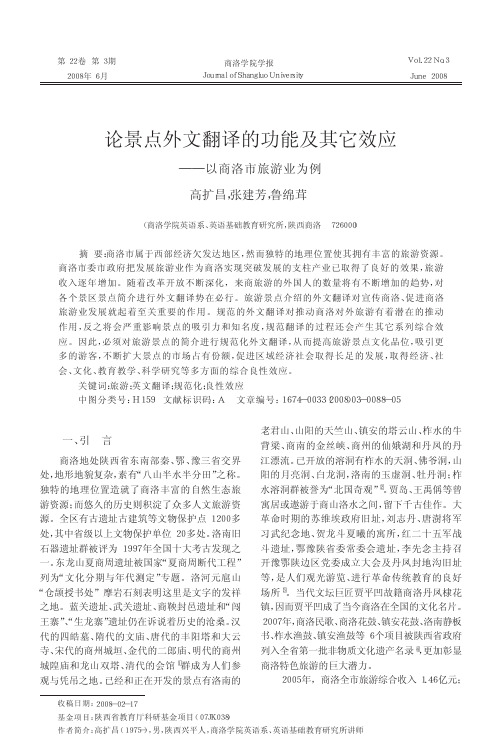
论景点外文翻译的功能及其它效应———以商洛市旅游业为例高扩昌,张建芳,鲁绵茸(商洛学院英语系、英语基础教育研究所,陕西商洛726000)一、引言商洛地处陕西省东南部秦、鄂、豫三省交界处,地形地貌复杂,素有“八山半水半分田”之称。
独特的地理位置造就了商洛丰富的自然生态旅游资源;而悠久的历史则积淀了众多人文旅游资源。
全区有古遗址古建筑等文物保护点1200多处,其中省级以上文物保护单位20多处。
洛南旧石器遗址群被评为1997年全国十大考古发现之一。
东龙山夏商周遗址被国家“夏商周断代工程”列为“文化分期与年代测定”专题。
洛河元扈山“仓颉授书处”摩岩石刻表明这里是文字的发祥之地。
蓝关遗址、武关遗址、商鞅封邑遗址和“闯王寨”、“生龙寨”遗址仍在诉说着历史的沧桑。
汉代的四皓墓、隋代的文庙、唐代的丰阳塔和大云寺、宋代的商州城垣、金代的二郎庙、明代的商州城隍庙和龙山双塔、清代的会馆[1]群成为人们参观与凭吊之地。
已经和正在开发的景点有洛南的老君山、山阳的天竺山、镇安的塔云山、柞水的牛背梁、商南的金丝峡、商州的仙娥湖和丹凤的丹江漂流。
已开放的溶洞有柞水的天洞、佛爷洞,山阳的月亮洞、白龙洞,洛南的玉虚洞、牡丹洞;柞水溶洞群被誉为“北国奇观”[2]。
贾岛、王禹偁等曾寓居或遨游于商山洛水之间,留下千古佳作。
大革命时期的苏维埃政府旧址,刘志丹、唐澍将军习武纪念地、贺龙斗夏曦的寓所,红二十五军战斗遗址,鄂豫陕省委常委会遗址,李先念主持召开豫鄂陕边区党委成立大会及丹凤封地沟旧址等,是人们观光游览、进行革命传统教育的良好场所[3]。
当代文坛巨匠贾平凹故籍商洛丹凤棣花镇,因而贾平凹成了当今商洛在全国的文化名片。
2007年,商洛民歌、商洛花鼓、镇安花鼓、洛南静板书、柞水渔鼓、镇安渔鼓等6个项目被陕西省政府列入全省第一批非物质文化遗产名录[4],更加彰显商洛特色旅游的巨大潜力。
2005年,商洛全市旅游综合收入1.46亿元;收稿日期:2008-02-17基金项目:陕西省教育厅科研基金项目(07JK038)作者简介:高扩昌(1975-),男,陕西兴平人,商洛学院英语系、英语基础教育研究所讲师摘要:商洛市属于西部经济欠发达地区,然而独特的地理位置使其拥有丰富的旅游资源。
语义翻译和交际翻译视角下景区标识语的英译
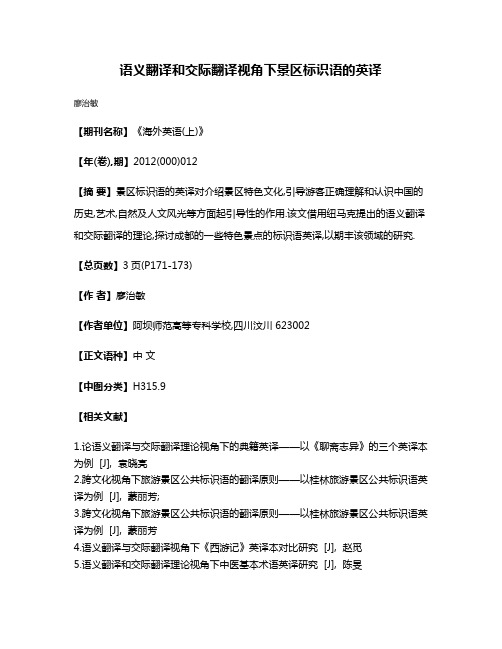
语义翻译和交际翻译视角下景区标识语的英译
廖治敏
【期刊名称】《海外英语(上)》
【年(卷),期】2012(000)012
【摘要】景区标识语的英译对介绍景区特色文化,引导游客正确理解和认识中国的历史,艺术,自然及人文风光等方面起引导性的作用.该文借用纽马克提出的语义翻译和交际翻译的理论,探讨成都的一些特色景点的标识语英译,以期丰该领域的研究.【总页数】3页(P171-173)
【作者】廖治敏
【作者单位】阿坝师范高等专科学校,四川汶川623002
【正文语种】中文
【中图分类】H315.9
【相关文献】
1.论语义翻译与交际翻译理论视角下的典籍英译——以《聊斋志异》的三个英译本为例 [J], 袁晓亮
2.跨文化视角下旅游景区公共标识语的翻译原则——以桂林旅游景区公共标识语英译为例 [J], 蒙丽芳;
3.跨文化视角下旅游景区公共标识语的翻译原则——以桂林旅游景区公共标识语英译为例 [J], 蒙丽芳
4.语义翻译与交际翻译视角下《西游记》英译本对比研究 [J], 赵觅
5.语义翻译和交际翻译理论视角下中医基本术语英译研究 [J], 陈旻
因版权原因,仅展示原文概要,查看原文内容请购买。
- 1、下载文档前请自行甄别文档内容的完整性,平台不提供额外的编辑、内容补充、找答案等附加服务。
- 2、"仅部分预览"的文档,不可在线预览部分如存在完整性等问题,可反馈申请退款(可完整预览的文档不适用该条件!)。
- 3、如文档侵犯您的权益,请联系客服反馈,我们会尽快为您处理(人工客服工作时间:9:00-18:30)。
HENAN INSTITUTE OF ENGINEERING外文翻译题目焦作云台山旅游目的地品牌营销研究学生姓名刘凯专业班级市场营销0842 学号200812111232系(部)工商管理系指导教师(职称)张建华教授旅游目的地品牌标识:以斯洛文尼亚为例摘要:本文旨在从供应一方来探讨旅游目的地品牌形象的概念,与那些关注以需求为驱动力的旅游者感知旅游目的地品牌形象的研究相比较。
研究人员和专业人士一致认为从品牌的标识和形象认知方面去分析品牌概念在合适的情况下是必要和不可分割的。
不过,这项研究认为,旅游目的地品牌的调查主要从知觉形象的角度进行。
因此,缺乏供应方研究可能会对旅游目的地品牌产生不平衡的看法、误解和疏忽,本文引用了一系列理论框架来设计分析旅游目的地的标识。
特别是对斯洛文尼亚的个案研究。
关键词:品牌标识品牌概念斯洛文尼亚旅游目的地品牌概念1.绪论尽管早期研究者们对从品牌概念到旅游目的地环境的转移持怀疑态度,这一概念在后期却引起很多研究旅游目的地的专家和学者的兴趣。
虽然旅游目的地能够被品牌化,但是我们依然要十分关注品牌原则到旅游目的地环境的转化。
这种方法可能会太过于商业化而损坏旅游景点的特色。
比如在全球环境下建立自身品牌所需要的社会关系、历史文化和风土民情。
这些都有助于使其与竞争者区分开来。
一些研究人员逐渐意识到文化概念中历史文化的特殊性,因此,旅游目的地品牌的发展应该坚持连贯的理论框架并且得到相关利益者的支持。
至今,大量的旅游目的地的研究相继从需求一方定义品牌概念。
这样就可能致使很多研究从消费者形象认知方面去了解旅游目的地。
相比较,供应商对旅游目的地品牌的观点却被全部忽视了,研究品牌概念的科学家和学者一致认为从供求双方分析品牌是必要的。
De Chernatony 甚至认为当今的品牌分析应该把品牌识别概念和品牌形象概念联为一体。
本文探讨旅游目的地品牌,从内部,即供应方的观点出发。
特别地是它有助于为片面一方提供选择,即从需求驱动的角度去认识旅游目的地品牌形象。
其主要目的是检查旅游目的地的标识分析的理论框架和在斯洛文尼亚的旅游目的地品牌的背景下的应用,由于最近斯洛文尼亚加入欧盟,这项研究就变得格外有意义。
随着欧盟的扩大,联盟和其成员各国需要定义其形象了。
欧盟的最小的成员之一,斯洛文尼亚,在面对双重挑战的情况下仍要维持其国家形象。
议会渐渐意识到在这项研究中外国势力可能会不可避免地蚕食其文化遗产。
特别是,应该如何斯洛文尼亚开发其旅游目的地的品牌标识,以便找到一个连续性和变化的力量之间的平衡?2品牌标识近日,致力于在业务和管理文学的品牌标识概念的专家和学者一直备受关注。
虽然作者们不能接受一个共同的定义,但是他们都有一个相同的意见,即品牌形象的发展最好从供应方的角度去理解概念。
卡普费雷尔(1998年,第71页)为获得品牌标识的更好理解,提供了一个非常简单和清晰的解释,他强调从供应方的角度考虑品牌概念的意义:“在知道我们如何观察之前,我们需要先弄清楚我们是谁”据他解释,旅游目的地而不是消费者,应确定其品牌和内容。
“以品牌标识为供应中心角度也被国际企业标识集团认可(1997年瑞尔与巴尔默引用)并且在Ind(1997)提出了企业形象的意义之内。
参与决策的权的企业所有者和旅游管理者是基于以前的定义看待标识在供应方中的角色。
此外一些定义认为分析品牌识别品牌角色就有了双重目的,随后计算出涉及消费者价值积累总和的品牌权益,以及他们对品牌的信心和忠诚度。
品牌标识明确规定品牌希望代表什么,并应有多重角色。
首先,品牌策略旨在创造和维持一系列的联系。
其次,它表示目标受众是如何看待这样一个特定的品牌。
最后,品牌标识应有助于建立一个特定的品牌和其客户之间的关系并由此产生涉及利益或提供信誉价值可能。
品牌标识概念的多重角色在调研中反映出来。
例如,卡普费雷尔(1998)介绍了一个六角形的模型称为品牌识别棱镜。
它是基于六个中心部分:体质、性格、文化、关系、反映或图像和自我形象。
后来,德·彻纳东尼的模型(1999)改编卡普费雷尔的品牌识别棱镜。
以前的概念学家在文化方面的品牌形象,推动其所需的定位,个性和随后的关系,所有这些都是后来提交反映利益相关者的实际和理想的自我形象。
在我们看来,阿克尔和Joachimsthaler的(2000)品牌领导模式在文学中是迄今为止最全面有以下三个原因。
首先,该模型是系统的。
在品牌标识的发展中打造品牌能够在众多理论中起着重要作用。
因此,为决策者研究利用以下三阶段结构的问题提供指引是有必要的:预分析的战略进程;旅游目的地的品牌标识系统的分析和品牌后的实施过程。
其次,该模型是全面的,即其品牌领导模式强调一定范围内的主题。
该模型包括经理的战略和富有远见的角色,而不是限制讨论他们的战术和被动的角色,它侧重于战略问题品牌的控制权,即设置一个从相关利益者角度看待此品牌有什么意义,包括客户和随后传递企业品牌的持续性,高效性和有效性。
再次,该模型是务实的,因为它认为决策者应该参与制定和实施的经营策略。
决策者的战略眼光和他们的企业文化对目的地的品牌战略有重大影响。
具体而言,它意味着一个目的地的品牌形象战略不应该承诺什么目标不能或将无法实现。
而阿克尔和Joachisthaler的与彻纳东尼模型是最相关的,目前,我们觉得前者的综合性最适合旅游目的地的特有概念的目标品牌范围。
3旅游目的地品牌形象框架在与他们营销和管理的同事相比,文献调查显示研究旅游业的社会科学家或多或少地忽视了品牌标识的概念。
后者把他们的重点放在调查旅游目的地感知形象。
虽然这些研究从旅游为中心的角度帮助我们理解旅游目的地,然而,他们对于从供应方考虑考虑品牌形象发展的影响,特别是在旅游旅游目的地品牌背景,或多或少地让我们蒙在鼓里。
这意味着,这项把营销文献(大多是“品牌理念)与旅游文学(主要是目的地的形象)相结合的研究尚处于起步阶段(蔡2002)。
目前最全面和最早期的工作文献清楚地强调图像的形成过程和品牌之间的区别。
这种看法是重要的,因为图像形成是品牌的代名词,前者是构成后者的核心。
即形象建设更近了一步,它与品牌形象缺乏关键的联系。
通过强调在目的地的品牌形象的概念的意义,蔡的工作已经确定了以前的研究,其中审查的弱点主要以客户为中心的角度看旅游目的地品牌。
此外,蔡(2002)提出了一个旅游目的地品牌的概念模型,通过围绕传播活动建立目的地形象。
后者来源于品牌要素的组合,形象建设,品牌联想和营销活动。
等动态间的联系。
该模型的另一个优点是它认为图像形成远远超出了旅游感知方法所包含的旅游目的地形象。
因此,评估认识和投影之间的差距是可能的。
这项评估为建立相一致的品牌形象和组织社会、历史、文化、自然因素提供了依据。
虽然蔡的旅游目的地品牌营销功能的作用模型被强调,而模型并没有详细阐述如何建立和发展特定的品牌形象目的地。
因此,我们力求从管理的角度对旅游目的品牌形象的理论框架进行阐述。
我们认为该框架在品牌领导模型中就被引用过,其根源于品牌形象概念的解释和理论代表。
它的基本原则,其中主要涉及产品或服务品牌均已纳入我们的模型。
由于旅游目的地的具体特点,产品、服务以及组织相结合的目的地品牌分类,我们对于是否了解具体品牌形象元素能够代表其转让特点要做出正确的评价,如果是这样,到达什么样的程度。
它指出,在当前的研究背景下旅游目的地品牌形象框架理论已扩展至独特的斯洛文尼亚,尤其是旅游目的地的特点。
品牌战略的分析框架包括三个主要部分:旅游者分析,竞争者分析和自我剖析。
首先,目的地必须进行系统化的旅游分析。
它应侧重于识别有关的新趋势和彻底了解游客的旅游动机。
除了提供世界旅游市场的大方向,这项工作应包含市场研究,尤其是一个合适目标市场和目标群体的发展。
其次,目的地也要对竞争对手分析。
它需要了解竞争对手的优势和劣势,以提高自身的竞争力。
例如,通过资本运转发现机会从而应对竞争对手没有注意到的现有旅游细分市场。
最后,目的地应该系统地进行自我分析从而确定其在市场上的真正位置。
因此,在整个链目标的自我分析中,品牌资产分析应该成为调查的重要组成部分。
目的地管理人员应通过合作的方式,而不是竞争方式来尊重不同目标水平的利益相关者的利益和愿望。
旅游目的地品牌标识系统代表目的地品牌形象开发过程。
目的地标识的核心应清楚地包含目的地的特色。
正如阿克尔和Joachimsthaler(2000)所说,目的地的品牌标识包括六到十二尺寸目的是充分描述品牌的愿望。
至少这些方面必须使旅游目的地区别与竞争者。
虽然,各个目的地标准不同,他们主要是以下四个品牌特点:产品品牌,标志品牌,组织品牌,个人品牌;以及满足特定的目标利益。
旅游目的地的特性,不仅包括产品和符号的特点,而且代表了一个组织和个人。
现代游客访问目的地就想体验该地感觉,因此,目的地品牌形象在象征利益上起着重要作用。
调查品牌具体特点时应该考虑旅游目的地的品牌形象的发展,同时处理好目的地文化,当地民众和游客的关系。
然而,人们应该知道文化产生于居民,尤其是小规模工匠和艺术家,并由外国游客的企业家提供。
为了与这些不同力量的规模文化和(国际)国内旅游(可接受)变化过程相匹配,繁荣和发展是一项艰巨的挑战。
旅游业面临的另一个挑战是加强其目的地的形象,而不是减除其形象。
一个好的品牌标识迎接可持续发展旅游目的地的品牌形象挑战。
所以应尽量避免字符侵蚀威胁,即从'地方'的社会意义转变到由完全商业利益驱动“非地方”意义。
实施旅游目的地的品牌标识系统最初应该是拟订品牌标识的位置,并在其后实施营销战略。
最终的实施步骤是跟踪品牌建设方案,这是战略品牌分析的第一道工序,也是衡量品牌权益。
4斯洛文尼亚的旅游目的地品牌形象发展4.1斯洛文尼亚旅游目的地斯洛文尼亚共和国成立于1991年,位于欧洲的心脏地带,在那里阿尔卑斯山面临潘诺尼亚平原和地中海接壤神秘的喀斯特。
其在中欧的地理涵盖只是20256平方千米的面积,使得它成为世界上最小的国家。
虽然面积小,斯洛文尼亚的地区却有各种各样的风景区,包括山脉,湖泊,海岸和喀斯特景观。
这样的自然条件为旅游业提供理想的机会,斯洛文尼亚旅游业由此成为最有前途的斯洛文尼亚经济部门之一。
2003年,斯洛文尼亚记录大约有140万国际游客和90万国内游客(斯洛文尼亚统计局2004年)。
一些研究者(霍尔,2000;奥林斯2002)支持作者的观点,认为斯洛文尼亚应该运用系统的方法来发展其品牌标识,目的是加强国家的品牌值(安霍尔特2000年)为现代化的强大的国家经济建设作出贡献。
迄今为止,尽管品牌发展的概念引起极大兴趣,没有数据显示斯洛文尼亚品牌标识的组成要素,尤其是斯洛文尼亚旅游局。
品牌形象的存在或不存在,对斯洛文尼亚旅游局营销业绩的影响应该优先以系统化的方式来定义它。
